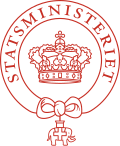| Permanent Secretary of State to the Prime Minister's Office | |
|---|---|
| Statsministeriets departementschef | |
 Seal of the Prime Minister's Office of Denmark. | |
| Prime Minister's Office of Denmark | |
| Type | Permanent Secretary of State |
| Member of | Council of State |
| Reports to | Prime Minister of Denmark |
| Seat | Christiansborg, Copenhagen, Denmark |
| Appointer | The Monarch on advice of the prime minister |
| Term length | No fixed term |
| Inaugural holder | Erik Arup |
| Formation | 19 December 1913 (cabinet secretary: 1848) |
| Salary | 2,875,500 DKK (€385,600) annually [1] |
The Permanent Secretary of State to the Prime Minister's Office (Danish : Statsministeriets departementschef) is the most senior civil servant in Denmark and the departmental head of the Prime Minister's Office. The person is the senior policy adviser to the prime minister and the Cabinet, and as the pre-eminent civil servant in the Danish central administration, the postholder serves as the symbolic head of the entire civil service (Danish : embedsværket). Since 1913, the permanent secretary has served concurrently as the cabinet secretary of the Council of State, the privy council of Denmark. [2] The role is currently occupied by Barbara Bertelsen. [3] [4]
Contents
- History
- Origin
- Powers and responsibilities
- List of permanent secretaries
- Secretaries to the Council President (precursor position)
- Permanent Secretaries of State
- References
- Citations
The position is the chief operating officer of the Prime Minister's Office and as the secretary to the Cabinet is responsible to all ministers for the efficient running of government. [5] [6] In addition to the formal duties associated with the permanent secretary, the occupant also handles important constitutional issues during a change of government, assisting the outgoing prime minister in transitioning to a new government during upcoming elections, as well as aiding the informateur (Danish : kongelig undersøger, lit. 'Royal Investigator') appointed by the Sovereign to investigate the possibilities of the formation of a coalition government. During this transfer and reorganization of executive power, the permanent secretary oversees the continuation of government responsibilities. [7]
The permanent secretary is formally appointed by the monarch of Denmark, following a nomination and recommendation by the government.
















